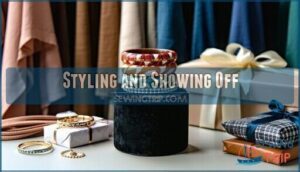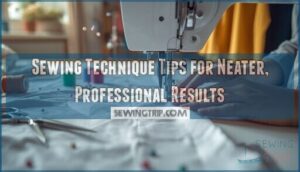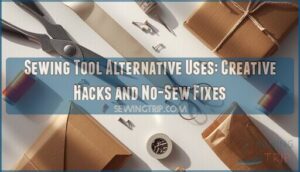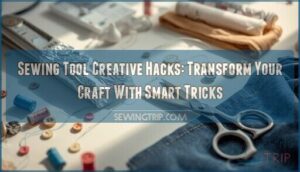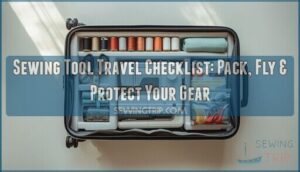This site is supported by our readers. We may earn a commission, at no cost to you, if you purchase through links.
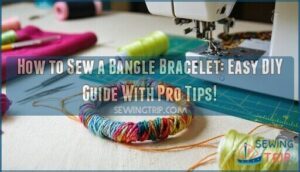 Learning how to sew a bangle bracelet isn’t rocket science, but it does require the right approach.
Learning how to sew a bangle bracelet isn’t rocket science, but it does require the right approach.
You’ll start with a plain metal or plastic bangle and your favorite fabric or thread.
Cut fabric strips about twice the bangle’s circumference, then wrap tightly around the base, securing each end with strong adhesive or tiny stitches.
For thread wrapping, anchor one end and wind consistently, keeping tension even – think of it like wrapping a present that won’t budge.
The trick lies in choosing materials that complement each other and mastering tension control.
There are several finishing techniques that’ll make your creation truly shine.
Table Of Contents
Key Takeaways
- You’ll start with unfinished wood bangles and cotton fabric strips (1.5" x 24"), using Mod Podge for smooth application and securing with consistent tension to prevent bunching or tearing.
- You need to sand rough edges first, then wrap fabric tightly around the base while maintaining 75% tension – firm enough to prevent wiggling but not so tight that you stretch the fabric itself.
- You can’t wash fabric-covered bangles safely since water damages the seal, so clean them by gently wiping with a slightly damp cloth and seal any fraying edges with fabric glue or clear nail polish.
- You’ll enhance your finished bangles by adding embellishments like tassels, beads, or charms, and style them by stacking 3-4 together or pairing patterns with your outfit for coordinated looks.
Materials Needed
Creating your first sew bangle bracelet starts with smart fabric selection and gathering the right bangle making supplies. You’ll need unfinished wood bangles as your base—they’re perfect for fabric scraps projects.
Choose cotton fabric strips measuring 1.5 inches wide by 24 inches long in patterns that speak to you. For adhesive options, grab Mod Podge and a foam brush for smooth application.
Don’t forget scissors and a plastic cup for organization. This sewing craft project transforms ordinary materials into something extraordinary.
Think of it as giving new life to fabric scraps while creating wearable art that’s uniquely yours. For alternative methods, consider wire bangle construction as well.
Preparing The Bracelet
First things first, you’ll want to tackle bangle smoothing by running your hand around the entire surface. Any rough spots will snag your fabric, so give them a quick sand if needed.
Now comes the fun part – fabric selection! Choose cotton that speaks to you, whether it’s bold florals or subtle stripes. This beginner sewing project is forgiving, so don’t stress about perfection.
Pattern alignment matters more than you’d think. Center your design before wrapping to avoid awkward placement. Start your fabric covered bangle by securing one end with a dab of glue, then begin snug wrapping around the base.
Keep tension consistent – too loose and you’ll get bunching, too tight and the fabric might tear. This fabric scraps project is perfect for using up leftover materials.
Edge finishing comes next, so trim excess fabric leaving about half an inch to customize bangle bracelet properly. You can also wrap the bangle with ribbon and use craft glue for securing.
Finishing Touches
Your bangle’s almost ready to steal the show! Once everything’s dried completely, grab some fine sandpaper for edge smoothing to eliminate any rough spots that could snag.
The magic happens when rough edges disappear and your creation transforms into pure wearable art!
Apply sealing techniques with a final Mod Podge glaze for protective coatings that’ll keep your creation looking fresh.
Now comes the fun part – embellishment ideas are endless! Add dangling tassels, colorful beads, or decorative buttons using proper sewing techniques.
Consider hardware additions like small charms or wire wrapping for professional finishes. Remember, smooth wrapping and a snug fit make all the difference.
To enhance the fabric’s texture, consider chemical softening options for a luxurious feel. Your wrinklefree masterpiece deserves these finishing touches!
Styling and Showing Off
Your beautiful handmade bracelets deserve to shine! These fabric-wrapped beauties are perfect arm candy that’ll have everyone asking where you got them.
Here are 5 styling tips to rock your new accessories:
- Stacking Bangles – Layer 3-4 together for that trendy, maximalist vibe
- Outfit Pairing – Match fabric patterns to your shirt or scarf for a coordinated look
- Occasion Wear – Dress them up for parties or keep it casual for coffee dates
- Gift Ideas – Present them in cute boxes as thoughtful handmade presents
- Fashion Trends – Mix textures by pairing with metal or beaded bracelets
Display your creations on jewelry stands to admire your handiwork. Consider how shiny fabric textures can add elegance. These handmade bracelets prove that fashion doesn’t need to break the bank!
Frequently Asked Questions (FAQs)
How to make a bracelet bangle?
Rolling up your sleeves is the first step!
Grab an unfinished wood bangle, cut fabric strips, and use Mod Podge to wrap tightly.
Sand smooth edges, add embellishments, and let dry completely overnight, this is a complete process to follow for the best results.
What gauge wire do I need for a bangle bracelet?
You’ll want 12 gauge wire for your bangle bracelet project.
This thickness gives you the perfect balance of strength and workability.
It’s sturdy enough to hold its shape while still being manageable for beginners to bend and solder.
What is the difference between a bracelet and a bangle?
Here’s the massive difference that’ll blow your mind: you slip a bangle over your hand in one solid piece, while bracelets have clasps or openings.
Bangles are rigid circles; bracelets flex and adjust perfectly.
What are the three types of bangles?
You’ll find three main bangle types: closed bangles (solid circles you slip over your hand), hinged bangles (open with clasps), and cuff bangles (open-ended styles that slide onto your wrist easily).
How tight should I wrap the fabric around the bracelet?
About 75% of DIY bracelet failures happen from loose wrapping.
You’ll want to pull that fabric snug—think firm handshake, not death grip.
Wrap it tight enough so there’s no wiggling, but don’t stretch the fabric itself.
How do I attach a clasp or other closure to my wrapped bangle bracelet?
Traditional wrapped bangles don’t need clasps since they’re solid circles.
If you’re creating an openable version, drill small holes near the ends and attach jump rings with lobster clasps using jewelry pliers.
How long does the sewing process take?
Like Rome wasn’t built in a day, your bangle won’t take forever either.
You’ll spend about 30-45 minutes sewing fabric onto each bracelet.
The drying time adds another few hours, so plan accordingly.
Can I wash fabric-covered bangles safely?
You can’t really wash fabric-covered bangles safely since water damages the Mod Podge seal and loosens fabric.
Instead, gently wipe them with a slightly damp cloth to remove dirt and dust.
What if my fabric frays during sewing?
Pinch the fraying edges, trim them carefully, then apply fabric glue or clear nail polish to seal the threads.
You can also use pinking shears to cut edges, preventing future fraying completely.
How do I fix uneven fabric wrapping?
Stop wrapping and carefully unwrap the uneven section.
Smooth out any wrinkles or bunching in the fabric.
Re-wrap that area slowly, applying gentle, consistent tension while smoothing the fabric flat against the bangle surface, using consistent tension to ensure a smooth finish.
Conclusion
Remember Sarah, who turned her grandmother’s vintage bangles into stunning conversation pieces for her wedding?
Now you’ve got the skills to create your own masterpieces. Learning how to sew a bangle bracelet opens endless possibilities for personalizing jewelry that matches your style perfectly.
With practice, you’ll develop steady hands and creative confidence. Don’t worry if your first attempt isn’t flawless – even experienced crafters started somewhere.
Grab those supplies and start wrapping your way to beautiful, custom accessories today, making your own unique conversation pieces!

